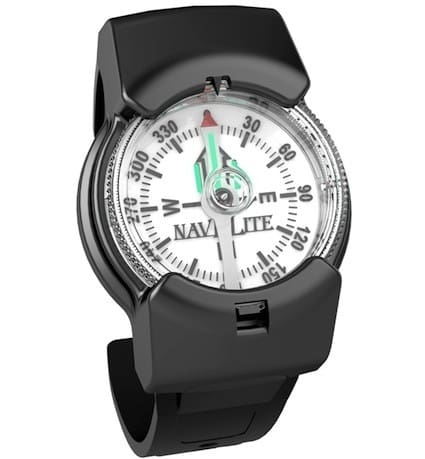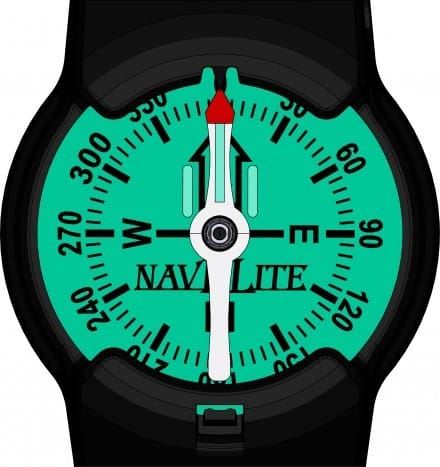We’ve been chomping at the bit to write about the new NavELite Backlit Magnetic Wrist Compass (BLMC). The company comes highly recommended by some folks that know what they’re talking about but we’ve held off because we’ve been wanting to get our hands on the actual product rather then just doing a “hey, look what’s coming” article. With 3 of the compasses on order we can assure you that we’ll be following up with some hands on.
Lately, so much has been happening relative to the BLMC that we couldn’t hold off writing any longer. For example, the BLMC has been approved for use at Ranger School. Here’s a little background.

Brief History
NavELite, LLC is a new business entity established in October 2010 to take over the navigational product initiatives originally spawned from Perception IR Manufacturing, LLC. The NavELite Backlit Magnetic Compass was invented and patented by two Special Operation soldiers during the onset of the Global War on Terror. Operations underscored the need for a reliable backlit compass during critical missions. It became apparent in the early stages of Afghanistan when soldiers had to routinely reference cardinal directions for tasks such as Close Air Support (CAS), adjacent unit coordination, and SATCOM antenna orientation that the current equipment available did not meet the needs of the soldier.
Company owners uncovered a government requirement for the development of a wrist-worn magnetic compass that had the ability to keep correct magnetic orientation while being illuminated from an electrically powered device. After a successful bid and proposal process, Perception IR Manufacturing was awarded a contract to design, build and deliver 205 prototype compasses to the Government. Final contract delivery was completed in November 2011 and NavELite, LLC assumed full control of transitioning the technology into a full line production.
Industry Outlook
Admiral Olsen who retired in late 2011 as the Commander of the United States Special Operations Command recently stated at an NDIA sponsored breakfast, “Cyber security is our most prominent future threat.” He went on to say that we must continue advancing technological capabilities within the force but should always be prepared for technology dependent items to fail such as satellite oriented Global Positioning System (GPS) devices. He was also quoted as saying, “I am proud to say that our SOF soldiers training at Ft. Bragg are still required to use a map and a compass before they even begin further training.”
Admiral Olsen’s (Ret) comments echo the concerns of Special Operations and conventional forces around the world. The United States and its allies must always be prepared to navigate in all types of environments even when GPS or other high tech devices fail. The NavELite backlit magnetic wrist compass is a low cost, lightweight and versatile low-tech solution for this requirement.
SOF Critical Requirement
SOF soldiers have historically needed to provide light to enhance the readability of a magnetic compass in low light conditions. This is becoming increasingly important in modern times because night operations provide tactical advantages for a technically superior military. An analog (magnetic) compass is often required in dense forests, deserts, jungles, caves, or other such austere environments where ambient light, particularly at night, is not sufficient to see a compass needle. These environments can also render GPS ineffective when the GPS receiver is blocked or obscured.
Some Soldiers will tuck a mini-chemical light under their wrist compass prior to conducting a night mission. This is a temporary solution but introduces the problem of a continuously glowing light on their wrist. Past attempts to improve compass face visibility have not provided acceptable results. Typical methods for improvement primarily focused on a light compass face or passive luminescent material that had to be “re-charged” with an external light source. Re-charging your compass in a night combat environment adds additional risk. Some attempts have been made with incandescent bulbs and light-pipe or indirect illumination. Lighting a compass in this manner tends to make the compass too bulky to be considered for a wrist mount model because the electronic components need to be separated from the magnetically sensitive compass needle. Regardless of the lighting method used, the compass accuracy cannot be affected. An error of just a few seconds of degree over distance can result in significant navigational errors.
Some soldiers have attempted to use new digital compass technology to bridge the identified gap because many of these types of compasses had the necessary backlight. Problems became apparent with digital compass technology including the requirement of frequent calibrations causing accuracy problems as a result. Additionally, if a digital compass loses power, the soldier is left with no means to navigate or even determine basic cardinal directions.
Another typical method used to illuminate a compass is through the use of the radioactive material tritium. Although tritium maintains its ability to remain charged and glowing for extended periods, the light produced is typically not sufficient for a soldier to gain a quick bearing. The tritium material is also a radioactive substance requiring special handling during manufacturing and disposal.
The Product
The present invention advantageously provides an illumination device (EL Panel) that produces little heat, is thin, flexible, shock proof, and resistant to catastrophic failure. The device can be powered by a small battery, produces distributive light and is non-glaring. Furthermore, the device can be incorporated into a compass design simply and easily at a relatively low cost.
Our patented backlit magnetic compass technology will allow military soldiers to rapidly acquire cardinal directions day and night, reducing night-time signature while providing the reliability of magnetic compass. The EL Panel provides back-lit illumination with no magnetic field interference.
NavELite completed the design and development of a wrist mounted version of this backlit magnetic compass technology. The wrist mounted compass holds a true magnetic bearing with or without the EL Panel being illuminated. This compass is designed to be compact, lightweight and a day/night reliable navigation tool effectively solving reliability shortfalls of presently fielded digital compasses.
The Competitive Edge
The NavELite compass is a simple concept combing pre-existing technologies to form a more useful product. The compass itself has been an enduring product that has stood the test of time. Barring a major magnetic disruption to the planet, the compass will remain a viable solution for any person with a need to determine cardinal direction. Currently, there is no other wrist mounted magnetic compass on the market that has an on-demand backlight.
Although GPS satellites and miniature gyroscope handheld smart phones offer SOF soldiers the ability to conduct precise navigation and direction finding, it is complicated technology that requires several preconditions to be met in order to function as designed. Absence of those pre-conditions, the high-tech solutions become ineffective. The NavELite compass will become the enduring reliable direction finding device that will continue to stand the test of time.
The most prominent competitive edge of the BLMC over any other wrist model magnetic compass on the global market today is the backlighting technology (no other wrist model magnetic compass offers a backlight). There are two major advantages the BLMC has over a digital compass; a depleted battery will not render the compass inoperable, and the EL Panel is night vision device friendly.
Relative Product Feedback
We have received multiple end-user field survey comments since the release of hundreds of prototype compasses to SOF soldiers. All of the feedback surmised that the backlit magnetic wrist compass was an invaluable asset and would be one of the most used pieces of soldier kit in the field. Much of the feedback requested that NavELite produce the next generation compass to include the following enhancements:
-Waterproofing
-Elimination of the four jewelers screws securing the battery compartment to be replaced by a plastic battery cover that could be secured or removed using a common flat object such as a dime or penny
-Shock resistance
-Extreme durability
NavELite will work diligently to provide these enhancements in the next generation BLMC model.
Tags: NavElite



would LOVE one for scuba diving. Waterproof and ruggedize that sucker!
They are working it.
Once it’s waterproofed, I will definately be buying one.
Really neat idea…but it’s not waterproof? That’s a little confusing. I’d definitely buy one if it was waterproof.
The compass will work when wet. However, the backlight can’t be immersed in water with the current model. You’ll be ok in a rain, but not a hurricane. Plus, I wouldn’t take it on an OTB op and expect the backlight to work.
Water resistant currently. Waterproof in the future. I’ve been wearing one for a couple of months now, have avoided submerging it, and have had no issues.
That hard wrist band needs to be detachable….and a lanyard attachment point worked in somehow…I’m already loaded up to the gills on forearm mounted equipment…at the very least make the wrist attachment through 2 Inch hard loops so the compass can be added to existing attachment bands.
Nice looking,but not very usable.The degree markings need to have long lines for each 10 degrees and short marks to indicate 5 degrees.Otherwise it’s confusing when trying to be accurate quickly from say,60-90 degrees in the picture.Each mark represents five degrees with no easy delineation.
Reading the heading and reciprocal under the lubber line is also obscured by the case covering and the needle is far to wide at at almost 15 degrees,should be between 5-10 degrees wide.
What does “night vision device friendly” mean? Does it mean it can be used while wearing NODS or that it won’t shine like the sun under NODS? Or both maybe?
I hope they can make it waterproof and get a better strap on the next model.
Looks like the one in the old survival kit.